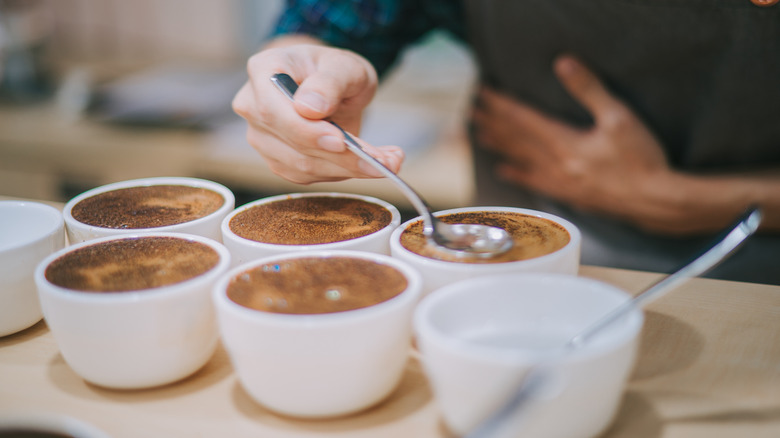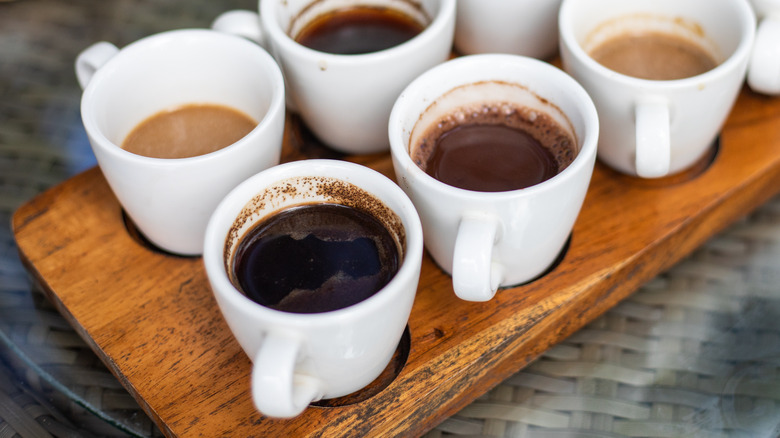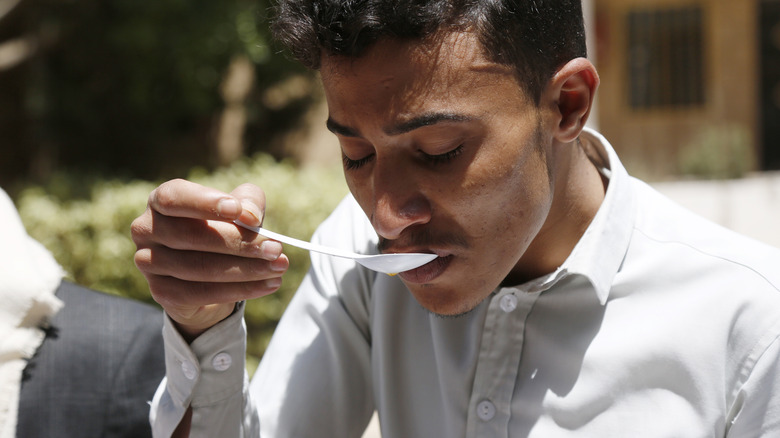What To Expect At A Coffee Tasting
If you've ever been to a wine tasting, then you're probably well familiar with the sensory experience it entails. From observing the unique characteristics of various bottles to savoring each one's complex blend of aromas and flavors, the entire affair lets you enjoy wine in a far more thorough and engaging manner. However, wine isn't the only beverage that you can evaluate while you drink it. Coffee tastings tantalize the senses in much the same, allowing you to appreciate brews in an entirely new way with every sip.
Similar to wine tastings, coffee-tasting events let you expand your palate well beyond your daily, go-to latte orders. Whether you want to refine your coffee taste preferences or explore the unknown by sipping on the enticing flavors of new brews, coffee tastings are an easy way to experience and compare a variety of different coffees at the same time.
From professional tastings at local coffee roasters to less formal get-togethers at home, each coffee-tasting experience is unique. Some may examine coffees from particular growing regions, whereas others may be less stringent, offering tasters an assortment of whatever is available on hand. However, all coffee tastings usually incorporate the same technique called coffee cupping, a process that helps you experience the different layers of flavors like never before.
The ins and outs of coffee cupping
Although coffee tastings may seem like a relatively new experience, the art of coffee cupping has been around since the late 1800s. During this time, merchants would use the tasting method to analyze various coffees before they bought them. Fast forward to today, and coffee cupping — which is often employed by coffee traders, roasters, farmers, and the like — is now considered the industry standard when it comes to evaluating the quality of various coffees.
Those attending a coffee-tasting event will be taught how to properly cup coffee, as well as how to distinguish the nuances in flavors. But essentially, coffee cupping involves using two spoons to try the brew: The first is used to pour a small spoonful of coffee into the second spoon, which is the one that goes into your mouth to taste. (You should have a cup of water at the ready too, so you can rinse your spoons in between each sip.)
Similar to the basic rules of tasting wine — swirl, sniff, sip, and spit (or see, swirl, sniff, and sip, if you're not keen on spitting) — the cupping sessions can flow in four different stages: smell, slurp, analyze, and describe. So, before you get a taste of the coffee, just be sure to give it a good whiff first, inhaling deeply to take in the various aromas.
Slurping is essential for experiencing the flavors
After the smelling comes the sipping. Although slurping is considered one terrible etiquette mistake people make with hot café drinks, it's actually encouraged among those who partake in coffee cupping, a group otherwise known as cuppers. Instead of taking delicate sips, don't be afraid to take a hearty, noisy slurp of the coffee, which will help ensure it reaches tastebuds all over your mouth.
Slurping the coffee will also help aerate the liquid as it moves across your palate, enhancing the heady notes in the process. This will come in very handy during the next phase of the tasting in which you analyze the various flavors. Just like the light, medium, and full bodies of wine, coffee is equally as complex in terms of structure, so you can take a moment to mull over the textures, too.
After analyzing the coffee, the cupping session will culminate with jotting down or describing what you experienced during the tasting. This will also give you the chance to share and compare your observations with others.



